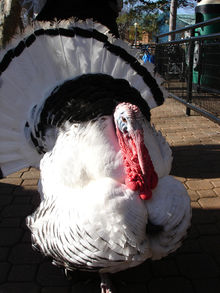Royal Palm turkey
 | |
| Country of origin | United States of America |
|---|---|
| Traits | |
| Skin color | white with bands of metallic black |
| Classification | |
| APA | Heritage breed |

The Royal Palm is a breed of domestic turkey. It is not primarily selected for meat production, and is usually kept as an ornamental bird with a unique appearance, largely white with bands of metallic black.
The Royal Palm first appeared in the 1920s on a farm in Lake Worth, Florida, apparently as a cross between Black, Bronze, Narragansett, and native turkeys.[1] Years of selective breeding followed to stabilize the coloring, and the Royal Palm was finally accepted by the American Poultry Association's Standard of Perfection in 1971. In Europe, a turkey with similar coloration is sometimes called the Cröllwitzer, Pied, or Black-laced White.[2]
Most heritage turkey breeds declined after the adoption of the Broad Breasted White by the turkey industry; the Royal Palm is an endangered breed and is classified as "watch" by the American Livestock Breeds Conservancy. It is also included in Slow Food USA's Ark of Taste, a catalog of heritage foods in danger of extinction. The Australian and United States both report the breed as endangered to the Food and Agriculture Organization of the United Nations.[1]
References
- ^ "BREEDS CURRENTLY RECORDED IN THE GLOBAL DATABANK FOR ANIMAL GENETIC RESOURCES" (PDF). ftp.fao.org. Food and Agriculture Organization of the United Nations. Retrieved 14 October 2014.
- Ekarius, Carol (2007). Storey's Illustrated Guide to Poultry Breeds. Storey Publishing. ISBN 978-1-58017-667-5.
- "Royal Palm". American Livestock Breeds Conservancy. Retrieved 2008-07-22.
- "Royal Palm Turkey". Ark of Taste. Slow Food USA. Retrieved 2008-07-22. [dead link]
